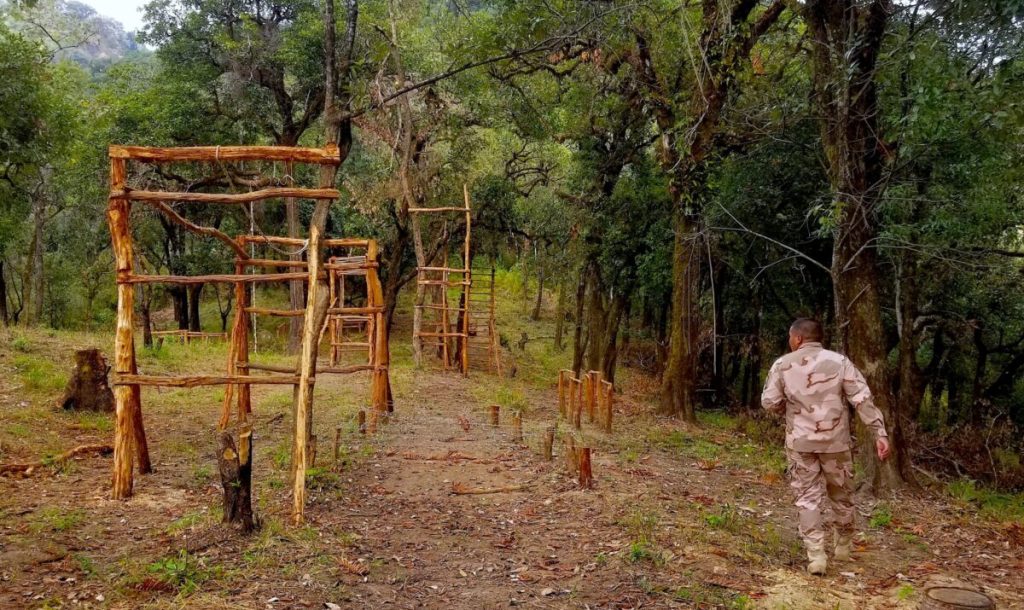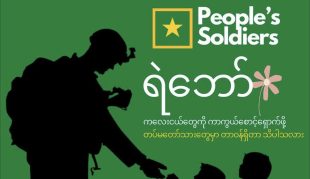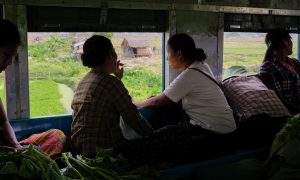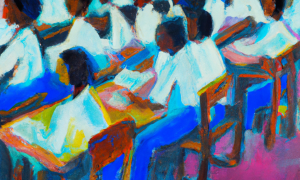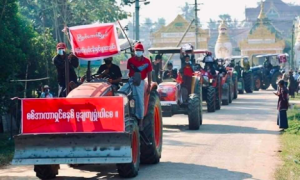Visiting troops of the 14th Army along the World War II India–Burma frontiers, Lord Mountbatten, then in charge of South East Asia Command, gave speeches acknowledging that they were called “the forgotten army” on the “forgotten front.” Sometimes he would add a line to make the soldiers laugh: “At home you are not forgotten—they have not even heard of you!” Mountbatten’s point—that you have to know about something in the first place in order to accurately consider it “forgotten”—also applies to present day Myanmar, as the revolution against the coup regime is incessantly being described in the same way.
Histories of the World War II Burma campaign sometimes note that a reporter first used the terms “forgotten war” or “forgotten army” for it. This person may have been the Daily Mail correspondent Graham Stanford, but the actual instance appears to have been, itself, forgotten. These phrases certainly played into a sense of grievance among British soldiers posted far from home in what was perceived as a remote corner of Asia, while campaigns in Europe and North Africa got far more press attention, resources and personnel. The Indian soldiers who formed the vast majority of the 14th Army likely had a different set of concerns.
In more recent years, books about World War II Burma have often used “forgotten war” or variations as titles. There’s even a strategy board game called “Burma: The Forgotten War.” For the 75th Anniversary of VJ (Victory over Japan) Day in 2020, the Royal British Legion produced an interactive website about “Why the Fourteenth Army, one of the main fighting forces in the Far East, became known as the ‘Forgotten Army’.”
Barnaby Phillips’ 2014 book Another Man’s War, about African troops who fought under British command in Burma, was described as an “account of a forgotten soldier in a forgotten army in a forgotten war” in a cover endorsement by Ferdinand Mount. World War II veterans from Burma (Myanmar), including Karens and Chins, are assisted by a UK-based organisation called Help 4 Forgotten Allies.
World War II Burma often echoes resoundingly in the current Myanmar revolutionary war, with fighting ongoing in many of the same places: Arakan (Rakhine State), Chin State, Kachin State around Myitkyina. Ethnic armies trace their lineage to founders who fought for the Allies, and the Myanmar coup regime is the product of an army originally trained by the Japanese fascists.
With a few exceptions (including Al Jazeera and the Guardian) international press coverage of the current war in Myanmar was very sparse and sporadic from 2021 to late 2023. Initially some stories depicted young people from the cities training in ethnic frontier areas, with an emphasis on their military inexperience and idealism. But the steady rise of People’s Defence Forces (PDFs) and their ethnic alliances into a full scale armed revolution went largely unreported by major international media.
Perhaps most of the foreign war correspondents gravitated toward Ukraine in 2022. Maybe the journalists (professional and “citizen”) of Myanmar who consistently have covered the war weren’t able to get their stories accepted by most international outlets. And it could be that editors of international news just considered Myanmar of only marginal interest, easily ignored, especially in comparison to conflagrations in Ukraine or the Middle East.
For a very long time, Myanmar had been covered internationally mostly as a narrative of eternal victimhood. Aung San Suu Kyi enduring house arrest. Jade mine disasters, Cyclone Nargis. The tragic images of Rohingya refugees fleeing genocide to Bangladesh. Peaceful protesters shot in the streets. That people all over Myanmar could take up arms in a massive revolution, fight effectively and claim victories, upsets that narrative. So even after the stunning victories in the north in late 2023, Myanmar resistance armies are still portrayed as marginal underdogs.
It’s true that resistance forces, including PDFs, lack support from other countries, continue to face arms and ammunition shortages and are vulnerable to air attack. But characterising the revolutionaries of Karenni State as the New York Times did, in an April 2024 article titled “A Ragtag Resistance Sees the Tide Turning in a Forgotten War”, is ludicrous. In comparison to the literally rags-clad captured troops of the coup regime, PDF and ethnic fighters are usually well-uniformed. They also mostly appear better-fed and more battle-fit than the regime’s troops. The Times’ use of “forgotten war” in their headline is ironic as the paper itself had neglected to consistently cover the war in Myanmar during most of 2022–23. Searching the New York Times website for coverage of the armed resistance in Myanmar, I’ve found only six stories in 2023 and six in 2022. Of those, four pieces were about regime airstrikes or other attacks slaughtering civilians in resistance regions.
Myanmar’s armed struggle against the coup regime had already been described as “forgotten” as early as 2022. Possibly such headlines meant that the street protests of February–March 2021 were forgotten—or that Myanmar’s overall existence was forgotten after that brief burst of attention. An intrepid Australian Broadcasting Corporation (ABC) film crew visited the Chin resistance and their documentary was aired August 2022 under the title of Myanmar’s Forgotten War, with the description “a civil war you’ve never heard of” featuring on the ABC website. A July 2022 Channel 4 documentary was called Myanmar: The Forgotten Revolution Dispatches.
Defection and revolution in Myanmar
For the first time, a resistance movement against military rule is welcoming and aiding soldiers who choose to join the ‘people’s side’
Some of the revival of the World War II “forgotten war” trope may relate to a statement to the United Nations Human Rights Council by UN Special Rapporteur on Human Rights in Myanmar, Tom Andrews, during his tireless but basically futile efforts to get the UN to do something—anything—useful about Myanmar, such as enacting an arms embargo. Andrews said in September 2022 that “[m]any in Myanmar have come to the conclusion that the world has forgotten them, or simply doesn’t care. They ask me why [UN] Member States refuse to take measures that are both possible and practical, measures that could save untold numbers of lives.”
In February 2023 CNN featured Andrews’ comment that the conflict “has been forgotten” and used “CNN obtains exclusive footage showing Myanmar’s ‘forgotten war’” as a photo caption and video headline for its reporting. This F word had become reflexive in international press coverage of Myanmar by 2023. Inter Press Service used the headline “Myanmar’s ‘Forgotten War’ Lurches Deeper into Horror” in April 2023. DW covered an exhibition in Berlin as “Myanmar’s Artists and the Forgotten Civil War” in July 2023 and in August the same year reported on “Myanmar — Ein vergessener Krieg” (a forgotten war), with the English version titled “Myanmar’s Forgotten Revolution.”
As well as press reports, “forgotten” is in use by international organisations: International Crisis Group titled a June 2023 podcast “Myanmar’s Forgotten War” and UNHCR titled an article about Rakhine State, “Displaced Families Yearn for Home in Myanmar’s Forgotten Conflict” that October. At the end of 2023, an ethnic alliance’s Operation 1027 was so dramatic—with its rapid town-taking in the north of Myanmar, shutdown of online scam centres and exposure of the coup regime’s weaknesses—that international media couldn’t help but take notice. The fighting in Myawaddy (right on the Thai border) and access to liberated Karenni State regions have also increased international coverage of the Myanmar revolution in 2024. Yet somehow major publication headlines maintain their amnesiac cliché, with the New York Times using the variation “overlooked” in April this year and in May the BBC broadcast a series of reports from Karen State using “Forgotten War” titles, with a presenter’s introduction including a description of Myanmar as “a country in the grip of a war largely forgotten by the outside world.”
Myanmar being ignored or called “forgotten” by international media can have an actual impact on momentum for aid programs and government actions. The marginalisation of news from Myanmar results in a lack of international support for anti-coup forces except from the diaspora and others who follow news from Myanmar on social media and through local press outlets.
Like Victorian ethnographers’ use of “vanishing peoples,” a “forgotten war” can become a self-fulfilling terminology. Today’s international community, which deliberately ignores the urgent needs and requests for basic support such as an arms embargo or sanctions on aviation fuel, can feel justified because Myanmar is considered forgettable—and therefore unimportant. The remedy would be more use of journalism by people from Myanmar in mainstream international media, more first-hand reporting, and fresh approaches to covering the war. Certainly the people of Myanmar will never forget the coup, this revolution, the lives sacrificed, the lives changed, and the transition from oppression into victory.
 Facebook
Facebook  Twitter
Twitter  Soundcloud
Soundcloud  Youtube
Youtube  Rss
Rss 